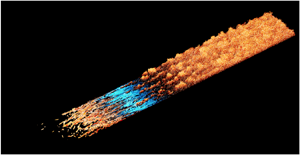Article contents
Shock-induced heating and transition to turbulence in a hypersonic boundary layer
Published online by Cambridge University Press: 21 December 2020
Abstract

The interaction between an incident shock wave and a Mach-6 undisturbed hypersonic laminar boundary layer over a cold wall is addressed using direct numerical simulations (DNS) and wall-modelled large-eddy simulations (WMLES) at different angles of incidence. At sufficiently high shock-incidence angles, the boundary layer transitions to turbulence via breakdown of near-wall streaks shortly downstream of the shock impingement, without the need of any inflow free-stream disturbances. The transition causes a localized significant increase in the Stanton number and skin-friction coefficient, with high incidence angles augmenting the peak thermomechanical loads in an approximately linear way. Statistical analyses of the boundary layer downstream of the interaction for each case are provided that quantify streamwise spatial variations of the Reynolds analogy factors and indicate a breakdown of the Morkovin's hypothesis near the wall, where velocity and temperature become correlated. A modified strong Reynolds analogy with a fixed turbulent Prandtl number is observed to perform best. Conventional transformations fail at collapsing the mean velocity profiles on the incompressible log law. The WMLES prompts transition and peak heating, delays separation and advances reattachment, thereby shortening the separation bubble. When the shock leads to transition, WMLES provides predictions of DNS peak thermomechanical loads within  $\pm 10\,\%$ at a computational cost lower than DNS by two orders of magnitude. Downstream of the interaction, in the turbulent boundary layer, the WMLES agrees well with DNS results for the Reynolds analogy factor, the mean profiles of velocity and temperature, including the temperature peak, and the temperature/velocity correlation.
$\pm 10\,\%$ at a computational cost lower than DNS by two orders of magnitude. Downstream of the interaction, in the turbulent boundary layer, the WMLES agrees well with DNS results for the Reynolds analogy factor, the mean profiles of velocity and temperature, including the temperature peak, and the temperature/velocity correlation.
- Type
- JFM Papers
- Information
- Copyright
- © The Author(s), 2020. Published by Cambridge University Press
References
REFERENCES
- 54
- Cited by





